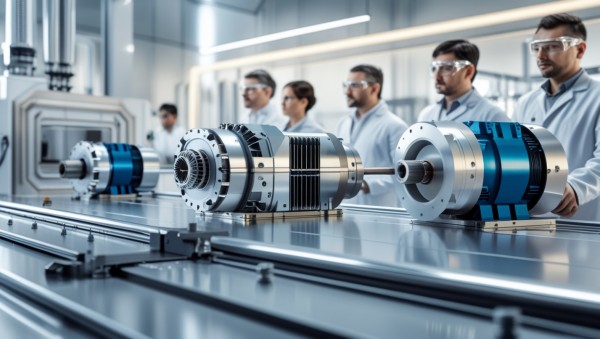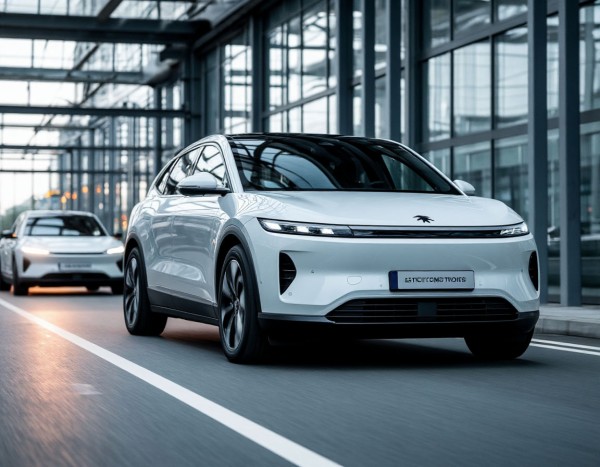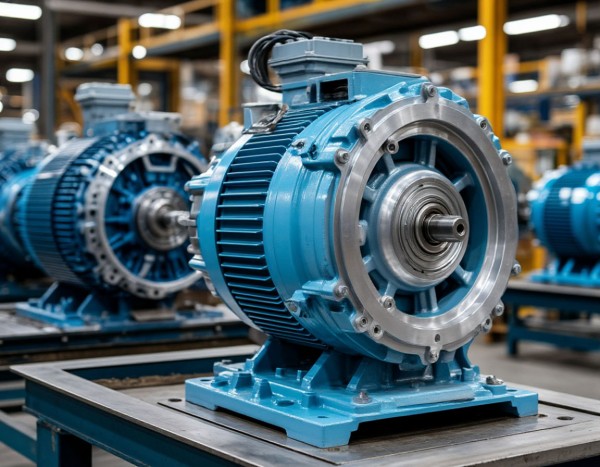Experts from iPrivod, a Russian Drive Technology Provider (Electric Motors, Soft Starters, and Frequency Converters), Have Prepared a Comprehensive Review Covering Key Trends and Innovations in Electric Motors for 2025.

The article presents an analysis of modern technologies aimed at improving the efficiency and environmental sustainability of electrical systems utilizing electric motors. It also examines cutting-edge solutions, including high-temperature conductors and smart power grids, which are shaping the future of energy and transportation sectors.
The Future of Electric Motors: Current Agenda for 2025 from iPrivod Experts
In today’s world, electric motors play a pivotal role across various industries – from manufacturing and transportation to power generation and household appliances. Each year, technological advancements continue to evolve, unlocking new possibilities for enhancing the efficiency, durability, and environmental friendliness of electrical systems.
In 2025, we are witnessing the emergence of innovative solutions that are transforming approaches to electric motor design and application. From high-temperature conductors to smart power grids – all these developments are becoming integral parts of a new era in electrical engineering.
This article explores the most relevant topics and trends in electric motor technology that are shaping the future of energy and transportation. Below is a list of key focus areas in the current electric motor agenda for 2025:
1. High Specific Power Electric Motors
In 2025, intensive development continues in creating electric motors with increased specific power. This direction focuses on developing motors that deliver greater power relative to their size and weight. Technically, this is achieved through new magnetic materials that facilitate more efficient magnetic field interactions. For example, certain magnetic alloys with enhanced magnetic properties enable stronger magnetic fluxes within the motor. Additionally, improved motor design architecture allows for compact component arrangement without compromising functionality.
These electric motors have found widespread application. In transportation, they have become crucial components of electric vehicles. The high specific power enables EVs to achieve greater speed and performance, enhancing their market competitiveness. In aviation, they may form the basis for electric drones or even electric aircraft. These aerial vehicles with electric motors demonstrate lower fuel consumption and reduced environmental impact compared to traditional combustion engines.
2. Smart Power Grids and Power Supply Systems
2025 sees active development of smart power grids. These networks are based on modern technologies like IoT (Internet of Things), artificial intelligence, and cloud computing. IoT devices installed throughout the power network collect data about grid conditions. They measure voltage levels, electricity consumption across different grid segments, and equipment status. This data is then transmitted to processing systems where artificial intelligence analyzes it.
Integrating such networks into existing power supply systems involves connecting various devices and subsystems. For instance, electric motors at industrial plants can be incorporated into smart grids. This allows centralized monitoring of their energy consumption, enabling optimization of industrial power usage. If a facility’s consumption exceeds normal levels at any point, the smart grid can automatically reduce power to certain motors without disrupting production processes. Such integration also enhances power supply reliability as the system can promptly respond to equipment failures and other disruptions. These topics were discussed at the “Current Issues in Power Engineering” 2025 conference, which explored various integration approaches and their practical applications.

3. Distributed Energy and Energy Storage Systems
The implementation of distributed energy systems is becoming increasingly relevant. Instead of relying on a single large power plant, energy is generated at various industrial facilities. For example, solar panels installed on rooftops can generate electricity for household use or feed into the grid. Small-scale wind turbines at industrial sites can also serve as power sources. In such systems, electric motors can drive fans for cooling solar panels or be incorporated into fuel preparation systems for microgenerators.
Energy storage systems like batteries play a crucial role when combined with electric motors. For instance, at solar power stations, when panels generate excess electricity, motors can activate pumps to redirect energy to storage batteries. This allows energy preservation for periods of reduced generation, such as nighttime or cloudy days. Thus, energy storage systems ensure power supply stability and enable more efficient utilization of energy produced by distributed generation systems.
4. High-Temperature Conductors and Increased Current Capacity
2025 sees intensive research into high-temperature conductor applications. These conductors represent specialized materials capable of carrying electrical current at elevated temperatures. They can be manufactured from special alloys or polymers possessing unique electrical and physical properties. These materials allow current transmission with lower heat loss compared to conventional conductors.
High-temperature conductors can improve electrical system efficiency. Since they can handle higher currents without significant heating, they reduce energy losses from conductor heating. For example, in industrial facilities requiring substantial power, using such conductors can significantly lower energy costs. They also increase permissible current levels, which benefits long-distance power transmission systems. This enhances the reliability and efficiency of electrical grids.
5. Electric Vehicles and Electronic Components
2025 continues to see active development and production of electric vehicles. Electric motors serve as central components in EVs, providing vehicle propulsion. Developers are focusing on improving motor characteristics – enhancing efficiency, extending vehicle range, and reducing weight. For instance, they’re employing new materials for motor shafts and windings that offer higher conductivity and lower weight.
Beyond the motor itself, EVs incorporate numerous other electronic components closely integrated with it. Motor control systems play a vital role, regulating motor operation based on various factors like vehicle speed, motor load, and battery status. These topics were discussed at Motor&Magnetics Expo 2025, where automotive and electronics industry representatives exchanged ideas about technologies that could improve EV quality and competitiveness.
6. Environmental Aspects of Electric Motors
Compared to combustion engines, electric motors have the advantage of producing no harmful emissions during operation. However, their manufacturing and disposal can negatively impact the environment. Producing certain components like magnetic materials may require substantial energy and resources. Additionally, disposing of batteries used with electric motors in EVs can release toxic substances if not handled properly.
Therefore, 2025 sees efforts to develop cleaner technologies. This includes searching for alternative motor production materials – such as biodegradable materials or waste-derived substances that would be less resource-intensive and more environmentally safe. Improving manufacturing and recycling technologies can also minimize environmental impact – for example, implementing production waste treatment systems that remove toxins from wastewater and emissions.

7. Innovative Materials and Technologies for Electric Motors
2025 research explores new materials for electric motors. Nanomaterials with unique electrical, magnetic, and mechanical properties are attracting particular attention. They can be used to manufacture motor shafts, windings, and magnetic components. For instance, nanocomposites can provide higher conductivity and magnetic permeability, improving motor efficiency.
Beyond new materials, emerging technologies like 3D printing of motor components are gaining ground. This technology enables precise fabrication of complex parts while reducing production time and costs by eliminating the need for specialized molds. Thus, novel materials and technologies are creating opportunities to develop more efficient and durable electric motors.
8. Ring Motors for Future Transportation
2025 sees active development of ring-shaped electric motors. These feature unique designs differing from conventional motors. They incorporate new materials and technologies that enable more efficient magnetic field interactions. For example, advanced magnetic materials used in ring motors can create stronger, more stable magnetic fluxes.
These motors could power various future transportation modes. In hypercars designed for extreme speeds, ring motors could provide more powerful and efficient propulsion, enabling smoother energy use and improved hypercar efficiency. They could also be used in drones, where their design could create lighter, more compact motors – enhancing maneuverability, flight duration, and energy efficiency.
9. Application of Electric Motors in Russia’s Energy Sector – Current Agenda
In the energy sector, electric motors play a critical role in automating technological processes. At power plants, they drive various mechanisms. Cooling fans powered by electric motors maintain optimal equipment temperatures, improving efficiency and lifespan. Motors also power fuel system components and emissions control equipment, enabling process automation, precision, and rapid response to changing conditions.
Additionally, electric motors are used in manufacturing electrical equipment. For example, in generator production – key components of energy infrastructure – motors can rotate generator rotors. They’re also employed in auxiliary devices needed for manufacturing, quality control, and generator installation. These issues were discussed at the Russian International Energy Forum 2025, where experts shared experiences and proposed new approaches to using motors in energy applications.
10. Current State of the Russian Electric Motor Market
Currently, Russia’s electric motor market has distinct characteristics. Domestic motor production spans various segments. Some manufacturers specialize in industrial motors used in factory automation – powering fans, conveyor drives, and other machinery. There’s also demand for household appliance motors. However, some production relies on imported components, making the market sensitive to external economic factors.

Russia’s motor market is poised for growth, driven by industries increasingly adopting electric motors. The automotive sector’s push toward EV production will require more motors. Government energy efficiency programs and industrial development support could also stimulate domestic motor production. Regarding exports, if Russian manufacturers develop competitive products, they could capture niche markets internationally. However, economic factors like currency exchange rates, tax policies, sanctions, tariffs, and raw material costs may significantly impact supply and demand dynamics in Russia’s motor market.
Disclaimer: The views, suggestions, and opinions expressed here are the sole responsibility of the experts. No Funds Spectrum journalist was involved in the writing and production of this article.
